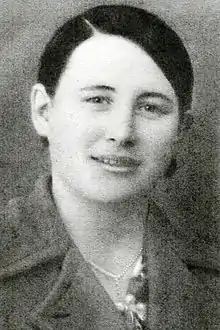Rosario Hernández Diéguez | |
|---|---|
 | |
| Born | 17 February 1916 Vigo, Spain |
| Died | 3 September 1936 (aged 20) Vigo, Spain |
| Other names | A Calesa |
| Occupation | newspaper hawker |
| Organizations | |
| Known for |
|
Rosario Hernández Diéguez (nickname, A Calesa; Vigo, 17 February 1916 – Vigo, 3 September 1936) was a Spanish Galician newspaper hawker and trade unionist, affiliated with Unión General de Trabajadores (UGT) and Spanish Socialist Workers' Party (Partido Socialista Obrero Español) (PSOE).[1] Raped, mutilated, tortured, she died young, a victim of Franco's repression.[2] A street in her hometown bears her name.
Biography
Rosario Hernández Diéguez was the daughter of an anarchist railwayman. Her home was on Calle Pino in Vigo. Everyone knew her by her nickname, "A Calesa".[3]
She worked as a newspaper hawker in the doorway of the society "El Gimnasio" on Calle del Príncipe,[4] reading out the news in the newspapers.[3] She visited the UGT's Casa del pueblo of the UGT, and attended PSOE meetings. In sympathy with the latter, she actively participated in the worker demonstrations of the time.[5][3]
Hernandez fled with the uprising of 18 July 1936. Captured and arrested on 3 September 1936.[lower-alpha 1] Imprisoned in the city's María Berdiales Fronton, she received meals brought in by her sister, Maria.[6] Insolent, rather than submissive, devoted and obedient, she was shaved, raped, mutilated, and murdered[5] in a Falange barracks. Her body was anchored to an iron grill[6] before it was thrown off a boat in the Ria de Vigo, near the Cíes Islands.[3]
Legacy
.jpg.webp)
A street in Vigo's Coutadas area, between the Os Rosais institute and Travesía de Vigo bears the name Rosario Hernández Diéguez.[3]
In 2021, the story, "Rosario Hernández é un lugar", written by Marcos López Concepción, won the VIII Vigo Histórico Contest, organized by Editoral Elvira.[5]
See also
Notes
References
- 1 2 "Rosario Hernandez: La Calesa (1916 - 1936)". hoxe.vigo.org (in Spanish). Concello de Vigo. Retrieved 1 March 2023.
- ↑ "Ruta por la huella de las mujeres de Vigo | Vivir Galicia". belaguaediciones.com (in Spanish). 10 February 2013. Retrieved 1 March 2023.
- 1 2 3 4 5 Rolland, Eduardo (9 December 2011). "El nombre de una calle". La Voz de Galicia (in Spanish). Retrieved 1 March 2023.
- ↑ Carbajo, Primitivo (1 June 2008). "Nombres de mujer para calles de Vigo". El País (in Spanish). Retrieved 1 March 2023.
- 1 2 3 "Vigo Histórico hace justicia con «A Calesa», la joven violada y fondeada en la ría por falangistas". VigoÉ (in Spanish). 6 October 2021. Retrieved 1 March 2023.
- 1 2 "De Misisipi a Madrid: brigadistas negros contra el fascismo / B.I. memoria en todo el mundo / Asesinaron a Rosario Hernández Diéguez / 270.000 presos a partir 1940 / Opus Dei: la falange invisible de la Iglesia. – PRES.O.S." (in Spanish). presos.org.es. 16 April 2021. Retrieved 1 March 2023.
Sources
- Aurora Marco (2007). Dicionario de mulleres galegas (in Galician). A Nosa Terra. ISBN 9788483411469. OCLC 1026020579.
- Lomba, Antonio Giráldez (1999). "Tres nombres en el recuerdo de Vigo hace sesenta años: "El Comandante", "El Rabioso" y "La Calesa"". Boletín del Instituto de Estudios Vigueses (5): 31–44. ISSN 1135-1810.